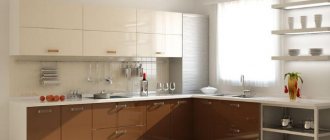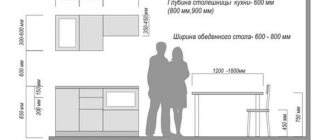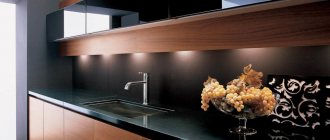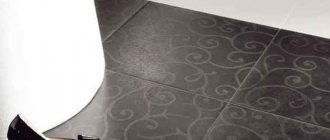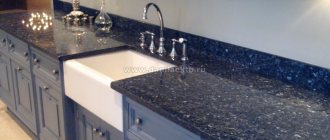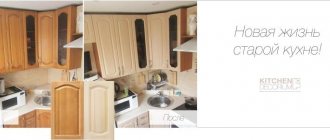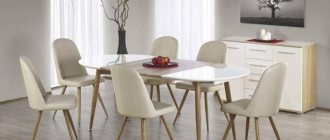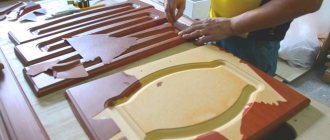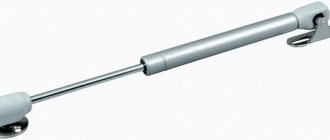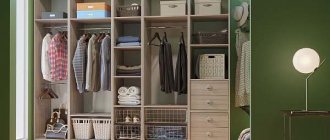The desire to have a cozy and comfortable kitchen space is understandable. It’s a pleasure to spend time in a beautiful and functional kitchen, prepare delicious food and communicate with loved ones. The main element of the interior, which also performs a large number of different functions in the process of preparing food, is the kitchen set. Therefore, it must be selected with special attention and responsibility. First of all, you need to think about the design, take into account the dimensions of the kitchen facades, whether the standard option will fit into the layout, what the details should be so that the purchase only pleases its owners.
In factories, as a rule, generally accepted standards are used in production. This standardization helps reduce production time and costs, and makes it easier for the buyer to select the right furniture and install it. However, size restrictions are not always convenient.
It is necessary to know the standards when developing a design, when choosing a headset, and especially if you decide to make it yourself, although this is very difficult.
Dimensional grid of furniture fronts for the kitchen
Dimensions of kitchen facades: tips for those who want to develop a project on their own
Dimensions of kitchen facades
Standards were developed based on data from many years of experience. In addition, ergonomic requirements are taken into account.
Standard dimensions:
- suitable for most women;
- make it possible to optimize the cooking process;
- meet the requirements for ergonomics and functionality;
- allow you to save on purchase/repair.
If the headset is designed independently, you need to know all the standard/non-standard parameters.
This table shows the most popular sizes of kitchen fronts.
| Hinged facades | Drawer fronts | ||
| Width, mm | Height, mm | Width, mm | Height, mm |
| 396 | 496 | 140 | 296 |
| 396 | 596 | 140 | 396 |
| 570 | 296 | 140 | 446 |
| 570 | 396 | 140 | 496 |
| 570 | 446 | 140 | 596 |
| 570 | 496 | 283 | 296 |
| 570 | 596 | 283 | 396 |
| 713 | 296 | 283 | 446 |
| 713 | 396 | 283 | 496 |
| 713 | 446 | 283 | 596 |
| 713 | 496 | ||
| 713 | 596 | ||
| 900 | 296 | ||
| 900 | 396 | ||
| 900 | 446 | ||
| 900 | 496 | ||
| 900 | 596 | ||
Grid of façade dimensions. Green cells are standard sizes.
Lower tier
The height of the bottom row of modules from the floor is 85 cm for a person up to 170 cm tall. For tall people, the cabinets can be raised by 5–6 cm. This arrangement allows you not to raise your arms above your waist while working.
The average depth of a kitchen unit is 45 cm, but the figure may vary depending on the size of the stove. It is important that this indicator coincides for both furniture and appliances, otherwise the stove will protrude forward, creating certain inconveniences when cooking and when moving freely around the kitchen.
The width of the cabinets can vary from 40 to 80 cm, while the width of the open doors should be no more than 40–50 cm. For small kitchens, it is better to select furniture with pull-out shelves in order to save space.
Typical sizes of kitchen worktops are 3–5 mm thick and 60 cm deep. To avoid pressing down electrical wiring, the surface should protrude above the main cabinet by 10 cm at the back, and also 5 cm at the front.
Upper tier
The standard height of a kitchen set is 50–90 cm, however, when choosing a set, you should take into account the height of the person. He should be able to reach the top shelf with his hand. If desired, the figure can be increased by the height of a stool or chair that a person can stand on. It is also recommended to take into account that the distance between the work surface and the lower facade of the upper shelf is ideally 45 cm.
The standard depth of wall cabinets is 30 cm, and the width should correspond to the width of the lower tier. It is recommended to install the hood 80 cm from the surface of a gas stove and 70 cm from an electric one. If these dimensions are exceeded, the efficiency of the unit will significantly decrease, and lowering the figure threatens the rapid failure of the hood due to filter burnout.
The total width of the front doors should be no more than 90 cm. This applies to both the upper and lower tiers.
What is a kitchen (furniture set)?
A set of kitchen furniture is a collection of individual elements (modules) pulled together. Each module consists of a frame and a front-mounted element (door). If the module is open, there is no door.
Any frame is formed by: two sidewalls, a lower and an upper horizon, plus one or more shelves. Instead of shelves there may be: drawers (one or several), metoboxes, retractable baskets, carousel, tandem boxes.
Two doors can be hung on one wide frame, opening in different directions, or several doors (one under the other). For example, for a floor module with parameters H=720 mm, L=800 mm, it is recommended to use two facades: 703*395. Thus, you get a double-leaf module with one or two shelves.
The hood is covered by a facade and does not fall out of the overall ensemble. The space under the stove is decorated with a drawer or closed with a fixed bar. The built-in dishwasher and washing machine are located between the modules (as close as possible to the communication means). At the front they are closed with movable facades.
Subtleties of using kitchen fronts of standard sizes
If the size of kitchen fronts from one manufacturer does not meet individual requirements, then there is a high probability that suitable options will be found from another manufacturer. The size range of models at furniture factories is constantly expanding.
The height of the frames of the upper wall cabinets should be made equal to the height of the facades (unless an open niche is planned). When the height of the selected facades is not enough, you can organize such a niche at the top or bottom of the module.
If one door is hung on the frame, then it should be 5 mm wider than the facade. Example: a frame with parameters L=600 mm, H=720 mm can be decorated with a façade of 703*595.
The height of the frames of the floor modules is greater than the length of the facades. If one door is hung, the difference is 17 mm. If there are several doors (in the case of a cabinet with drawers), then this value must be multiplied by the number of moving elements. In this case, the doors will open easily without catching the drip tray on the countertop.
When 2 modules with hinged doors form a right angle, their frames must be wider than the facades intended for them by 45 mm each. This is done to ensure freedom of movement of the doors. The resulting gap is covered with a corner decorative false strip. Of course, the extra millimeters of the frame are where the corner is.
Decorative inserts, frames, stained glass windows, consoles and balusters are made to fit standard sizes of kitchen facades. By correctly selecting elements of different sizes, you can create a project for a sideboard for dishes with an open shelf and glass inserts, or a chest of drawers for storing kitchen textiles and much more.
Which parameters to choose: standard or non-standard
Any manufacturer offers a choice: modular kitchens or custom-made kitchens.
Advantages of standard dimensions:
- it is easier to create a project;
- easier to select components;
- the cost is lower;
- options are offered for rooms with low and high ceilings.
To produce a standard set, there is no need to rebuild the equipment. Time and labor costs are standardized.
Advantages of non-standard parameters (custom-made or made independently):
- efficient use of space;
- filling optimization;
- implementation of an individual solution.
It is important to take into account the limitation: the minimum dimensions of the facade are 11x59.6 cm, the maximum are 252x92 cm. The production time is extended by several days. Deviation from the standard dimensions of MDF kitchen facades leads to a 20% increase in cost at the factory. When used for the manufacture of expensive materials, the sets are also more expensive.
General information about size standards
Manufacturers offer two types of facades:
- standard;
- arbitrary.
The first type includes doors of sizes that are available in the manufacturer’s assortment, so their manufacture does not require changing equipment settings, that is, the process follows a given pattern. Arbitrary facades do not go beyond the maximum and minimum dimensional values, but differ from the standards in the ratio of width and height.
For the manufacturer, the cost per square meter of a non-standard facade is 20% higher than that of a standard one, and this is reflected in the price set for the customer. If the headset is made of expensive material, then the difference can be significant.
Selecting the dimensions of facades according to standard values will help save a significant amount, so it is advisable to rely on dimensional standards when designing. Of course, it is not always possible to follow this rule, but even part of the facades that meet the standards will help reduce the final price for the set. In addition, a standard project will be produced faster. Now let's figure out how to calculate the sizes of facades and modules for the kitchen?
Typical dimensions of facades for kitchen furniture
The average kitchen area of a city apartment is 9 m2. The set consists of modules connected to each other.
Facades are:
- deaf;
- in the form of showcases;
- doors, drawers.
In addition to straight lines, there are radius ones (curved or concave). It is more difficult to select parameters for them.
Depth of the working area in the kitchen
Recommended tabletop depth is 600 mm. This size will allow you to easily integrate “essentials” (sink, hob, etc.). The minimum depth of drawers is 460 mm, optimal is 560-580 mm.
If the size of the room allows, the depth of the working surface can be increased to 900 mm. Then the depth of the drawers is at least 760 mm. In professional kitchens, as well as in loft-style rooms, worktops with a depth of 1200 mm look good. Such a large surface is best installed in the center of the kitchen. This is a multifunctional table (also called an island) that increases the comfort of the kitchen and allows you to conveniently move to other workspaces.
To select the ideal depth of the working area, it is necessary to take into account the length of the arms of the person who most often prepares food in the family, as well as the dimensions of built-in appliances and tabletop household appliances.
Hinged door sizes
Hinged doors for kitchen cabinets are produced in heights (cm):
- 39,6;
- 57;
- 71,3;
- 90.
For individual orders from MDF (cm):
- 47,6;
- 53,6;
- 59,6;
- 63,2;
- 91,6;
- 95,6;
- 130.
Width(cm):
- 39,6;
- 57;
- 71,3;
- 90.
The parameters are calculated for standard height (1.7 m). If one of the family members is much shorter or taller, using such lockers is inconvenient.
Taking measurements
First, decide how much area of your space there is for the kitchen, and how you plan to place the kitchen unit.
Next, measurements are taken. Here you need to pay attention to the following points:
- First measure the height from the floor to the ceiling. Please note that in many homes, indicators may differ at different points in the room. Because of this, mounting cabinets directly to the ceiling is potentially dangerous. After all, the height may not coincide in different angles;
- Then you need measurements from wall to wall. This refers to opposite surfaces;
- Don't forget to take measurements of door and window openings;
- Indicate on the diagram the free space required for the free opening of doors and windows.
Currently, you can find 2 types of kitchen sets. These are standard and non-standard.
Distance between kitchen furniture facades
For swing doors, the height is 3 mm less than that of the body, the width is 4 mm. The widths of the boxes are the same. In height, 3 mm is subtracted from the frame parameter. The parameters for the upper cabinets, which open vertically, are the same.
Indentations when installing facades
In tall cabinets for built-in appliances, it is important to take into account the gaps specified by the appliance manufacturer. For the refrigerator it is 4-5 mm, above the oven 5-7 mm. Sometimes sticks are mounted above microwave ovens; its thickness must be taken into account.
Gaps when installing a refrigerator
Correct installation of the oven
Hob installation parameters
Dimensions of beveled end cabinet doors
Often a row of kitchen or wardrobe cabinets ends with an end module with a beveled door. Its width is calculated by analogy with the previous option with the only difference.
Initially, you also need to calculate the width of the opening. Here you need to be prepared that the basis will not be a regular triangle with equal legs.
Add 8-10 mm to the resulting opening width, depending on the thickness of the sidewalls. This is necessary so that the facade is covered by the end and it does not “look through” against the general background of the single façade part.
Advice! Do not try to calculate the dimensions of the radius front for a cabinet with a concave or convex shape. As a rule, this is useless - most manufacturers limit themselves to producing standard shapes of certain sizes. Here they act from the “opposite”: they find out the dimensions of the door and design a cabinet for it (or use ready-made diagrams, usually developed by the manufacturers themselves). And the remaining modules are “adjusted” to the resulting corner.
“Furniture” mathematics – how to do the calculations correctly
Calculations should begin with developing a plan for arranging furniture. It is advisable to first focus on the table of standard sizes of kitchen facades.
The principle is simple: the gap must be subtracted from any façade parameter. A separate calculation must be made for each locker.
Why is it difficult to build a kitchen?
So why is installing a kitchen so “difficult”?
There are two key factors that make this difficult.
The first factor is people and interaction.
To build a kitchen, you need to come to an agreement with all participants in the process: with the client, with the builders and sometimes with the installers. Who takes on this role?
The general practice in Russia today is this. The client independently resolves all issues separately with the builders and separately with the designers. And, unfortunately, that’s why he simply doesn’t see mistakes, both in the work of designers and in the work of builders. A “deaf telephone” ultimately leads to errors being discovered during furniture installation. Debriefing begins and the search for those to blame begins. Although in essence there is no one to blame (some were not informed, others did not understand) - the wrong path was simply chosen initially.
The general rule is this: when different groups of people (builders, designers and furniture makers) come into contact with each other, whose common goal is to complete a “common” project, it is very important to immediately establish communications between them and act synchronously.
It's very easy to do. Create a group in any messenger (WhatsApp, Viber, Telegram) and conduct any discussions about the kitchen there. Even if issues are discussed there that are not directly related to construction work, the presence of other people in the chat will still allow them to see a potential problem in advance.
Each specialist has different experience, so any additional information from any side will be useful. In essence, there is mutual control and a search for balance. The role of the client, as an organizer, is to try to establish interaction between the designer, furniture designer and builders. And then he will get the desired result.
Bottom row
The typical depth of the bottom row cabinets is 60 cm, the thickness of the countertops is 3-5 cm, less often 6 cm.
When calculating the height of the doors, subtract:
- 1 cm (distance to floor);
- tabletop thickness;
- gaps (from the table top to the door 1-3 mm, between the doors 3 mm).
If the doors are double, the distance between the facades is 3 mm. If there is a drip collector in the countertop, the distance to the door is 4-5 mm.
If the row is too wide, you can insert elements for containers with spices or bottles into the free space.
How are sizes calculated?
For those who want to independently design a headset, including a non-standard size, they should know how the calculation occurs.
The gap is necessary for the correct functioning of the furniture. There are no specific requirements for this value, but according to generally accepted experience, in most cases it is 1-3 mm.
To calculate the height and width of the fronts, use the following formulas:
- Front height = cabinet height – gap;
- Front width = body width – gap.
To calculate hinged cabinets and drawers under the countertop, you can derive your own formulas. The main principle that needs to be followed here is the accurate calculation of gaps (both quantity and millimeters).
For detailed instructions, watch this video:
Corner models
Typical cabinet sizes:
- height 85 cm;
- width 24-80 cm;
- depth 40-80 cm.
They are:
- floor;
- hanging.
The calculations differ little from those used for direct models. The only exception is an increase in the distance between the doors by 1-2 mm.
Tabletop dimensions
Countertops are divided into ready-made ones with and without postforming. A postforming tabletop implies the absence of edge material on the front part of the product. The covering is the original dam of plastic, which envelops the front end of the tabletop along with the working horizontal. It looks reliable and does not allow moisture to get inside the product. Without postforming, the end of the tabletop is processed with a plastic edge. The thickness (height) of the kitchen countertop depends on the manufacturer:
- Imported countertops Duropal, Odyssey (Germany), McMart (Italy) have a thickness of only 38 (40 mm).
- Russian countertops can be 26, 28, 38 mm thick.
Standard dimensions of facades for non-standard kitchen furniture
Creating a headset with non-standard parameters begins with measuring the room and determining the budget.
You need to measure:
- length/width;
- ceiling height;
- all angles (they must be 90 degrees).
Example of a kitchen measurement scheme
Defects are eliminated or taken into account in the calculation.
If you have a small budget, narrow cabinets are more profitable (25% cheaper). You should also not include niches for equipment in the set.
The following determines the installation type:
- in one chain;
- in two chains (along opposite walls);
- letter "G";
- the letter “P” (for a large apartment or house outside the city);
- with a protrusion (letter “T”).
- with a separate island (for rooms with an area of 25 m2).
Calculation of gaps for a box with two facades
In this case it will be a little more difficult. As a rule, both facades have the same shape and size, which means everything will have to be calculated according to exactly the same principle. Just take into account the small distance between the doors so that they open well. One or two millimeters will be enough.
Scheme for calculating gaps for a box with two facades
These tips will help you with the calculations, but in essence they are general; for greater detail of the material, you need to additionally study special literature and watch detailed training videos on the Internet, then the work will be done efficiently and will only bring pleasure.
If you decide to purchase a ready-made set, then you can easily use a table with standard indicators when planning. It will help you decide on the delimitation of space and save on price.
Make furniture yourself or contact a professional manufacturer – it’s up to you. Remember that closets should be as comfortable, spacious and look beautiful as possible. Well, we can’t forget about quality and wear resistance. If these parameters are met, the kitchen will truly become a decoration of your home.
An important characteristic is the location of communications.
When choosing the type of lockers, the family's lifestyle is taken into account. If the housewife often cooks, a large work area is required. Otherwise, it is more advisable to order more wall shelves and models with drawers.
First, a sketch of the placement of objects is created. Drawings are created for each cabinet, taking into account niches and projections in the walls.
Next, you need to decide on the performer. The term “non-standard sizes” is conditional. Each manufacturer has its own size restrictions. Before developing the final version, it is necessary to find out exactly what the maximum and minimum parameters are for a particular manufacturer. If you have a website, non-standard and standard sizes of furniture fronts for the kitchen can be found via the Internet.
General aspects
If you look at the statistics of people’s queries in search engines, you can see that the topic of “building in a kitchen” is of concern to many people today: clients, builders, manufacturers, interior designers and design designers. And this is no coincidence.
When we go to various sites and portals that talk about interior design, furniture and kitchens, we see beautiful pictures where all the furniture is built neatly and without gaps.
Interior designers, when making or ordering visualizations, as a rule, do not take into account gaps and draw everything perfectly straight. Glossy magazines sometimes retouch and modify photographs of interiors, eliminating gaps and installation errors. And so, the client with the desire and need to get a built-in kitchen without gaps rushes around the Internet, trying to find a solution to his problem.
A beautiful design project for an apartment, but it’s difficult to implement everything in the same way. Work by Dmitry Kravtsov
Approximately the following questions arise in the consumer’s head: where can one order such a kitchen? Why does everyone make such indents? Where do such beautiful designs come from then? Does anyone make them?
There is also a myth that a built-in kitchen is an expensive kitchen. Many authors of articles spread it as one of the disadvantages when choosing such a kitchen. Taking up this idea, many manufacturers use this argument for their marketing purposes. Which is not good for the end consumer.
Building in a kitchen is, first of all, choosing the right operating algorithm. And you will understand this by studying the methods of integrating a kitchen into a niche, which I will describe below in the article.
Kitchen cabinet doors, dimensions
Most often, doors are made from:
- laminated, veneered, PVC or acrylic-coated chipboard;
- laminated with PVC, acrylic, veneered, trimmed with plastic panels or photo printed MDF;
- array;
- glass in an aluminum frame.
Since the size of the doors differs little from the size of the body, you should not make too large facades from solid wood. Large glass elements are also not desirable. It is also important to take into account the door span of 40-50 cm. Not all manufacturers produce doors made of solid wood and MDF with glass. This also needs to be clarified with the specific manufacturer.
How to calculate the weight of facades
Calculating the weight of facades is important if a non-standard size is taken and there are doubts about the strength of the fasteners. By default, it is recommended not to make the width of the swing facade more than 500-600 mm. The hinge may not support the weight of the door and over time it will either tear out or become warped without the possibility of adjustment. It will skew - that is, the unfixed edge will sag.
But to a greater extent, the weight determines the inability of the hinge to “hold” horizontal adjustment. Therefore, it is important to check everything at the design stage, to correlate the installed weight of the façade with the load-bearing capacity of the fasteners, as stated in the manufacturer’s recommendations. You can calculate the weight of facades based on the following examples:
Do you use laminated chipboards from other manufacturers and MDF of different densities and thicknesses in production? Just find out the source data on the official websites of the manufacturers and perform similar actions. The calculations will be correct if you use their principle to calculate the weight of facades made of acrylic, glass, solid wood, plywood and other materials.
Source
What you need to know about curved facades
A modern solution is considered to be radius facades, curved inward or outward. Separate height parameters have been developed for them (cm):
- 53,6;
- 57,3;
- 71,6;
- 95,6;
- 131,6.
The width corresponds to that of traditional cabinets.
When choosing radial doors, it is also advisable to clarify whether they are manufactured in the selected workshop.
Typically, furniture of non-standard sizes is required for a kitchen with an atypical shape. The space needs to be used rationally; standard furniture does not allow this. You can try to develop sketches yourself. However, it is not easy to ensure that the filling is comfortable and functional, everything fits perfectly to the walls. It makes sense to think through furniture drawings yourself only if you yourself will manufacture the cabinets and facades.
In fact, the headset project is complex; development requires special knowledge. There are nuances that a non-professional cannot take into account. If the design is incorrect, the new furniture will not bring joy. It turns out that money and time were wasted.
If you have a limited budget, it is more profitable to stick to standard parameters. Changes should only be made in special cases. This may be the non-standard height of the housewife, the inconvenient shape of the kitchen, the presence of niches or protrusions on the walls. It is important to take into account all factors, features and rules. The standard sizes of kitchen facades were developed for good reason. In special situations, it is also not worth designing all items according to non-standard sizes. This will reduce the final cost.
How to calculate the area of facades
The most convenient way to calculate the area of facades is to create a table in Excel and enter the corresponding formulas for multiplying height*length*quantity and total summation.
It's based on simple mathematics. To calculate the area of the facade, you need to multiply its length by its width. Next, multiply by the quantity. And add it up with the rest if you need to calculate the total area of the facades.
